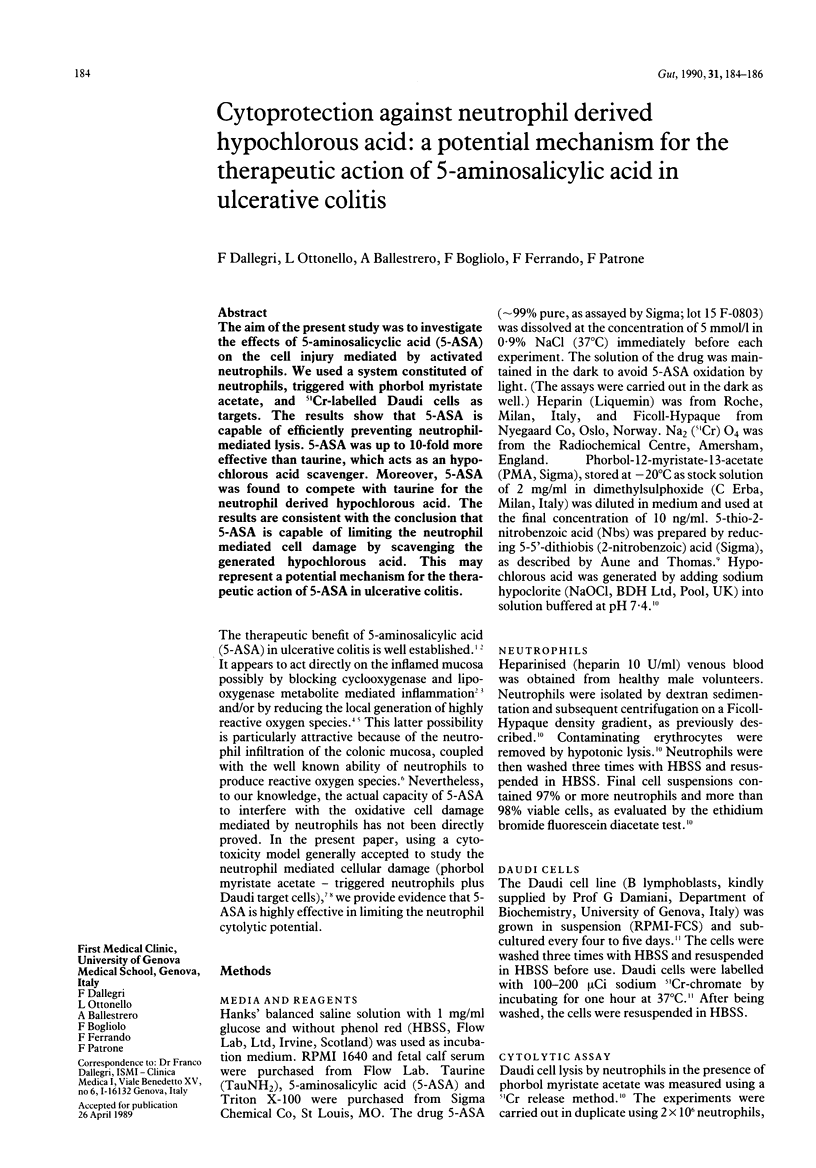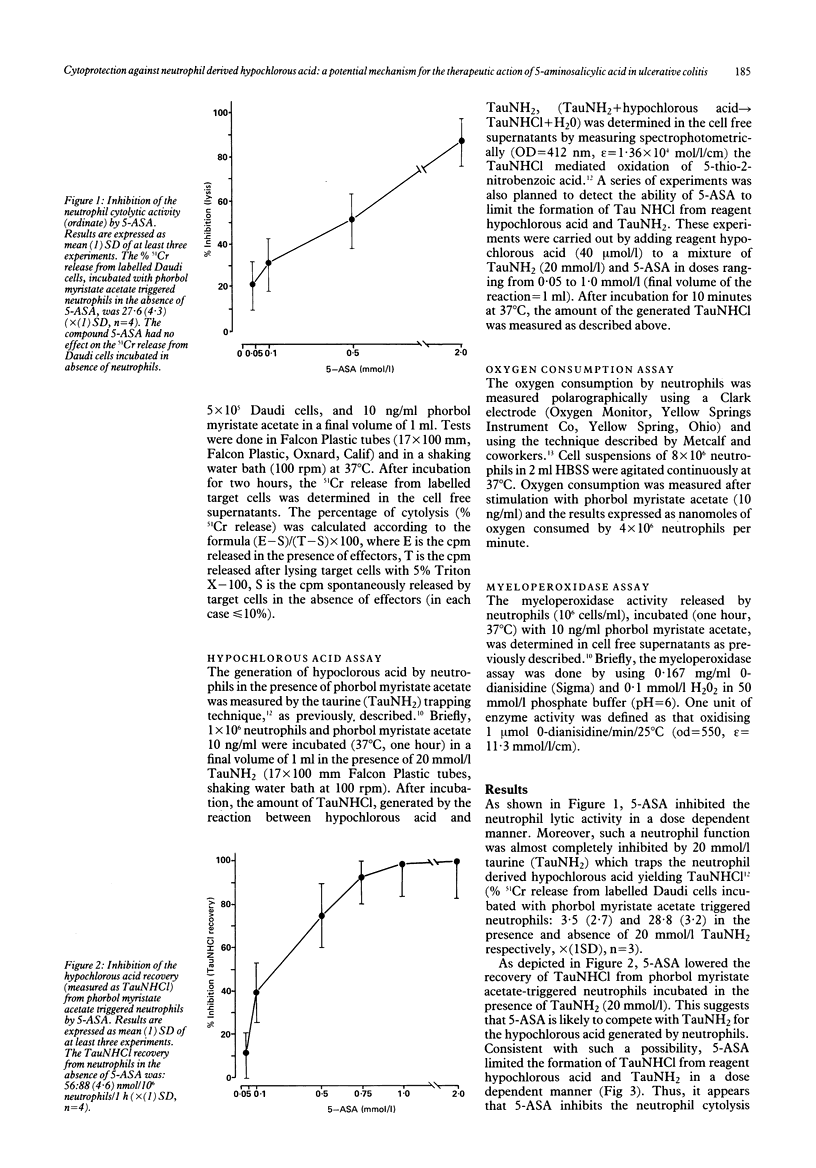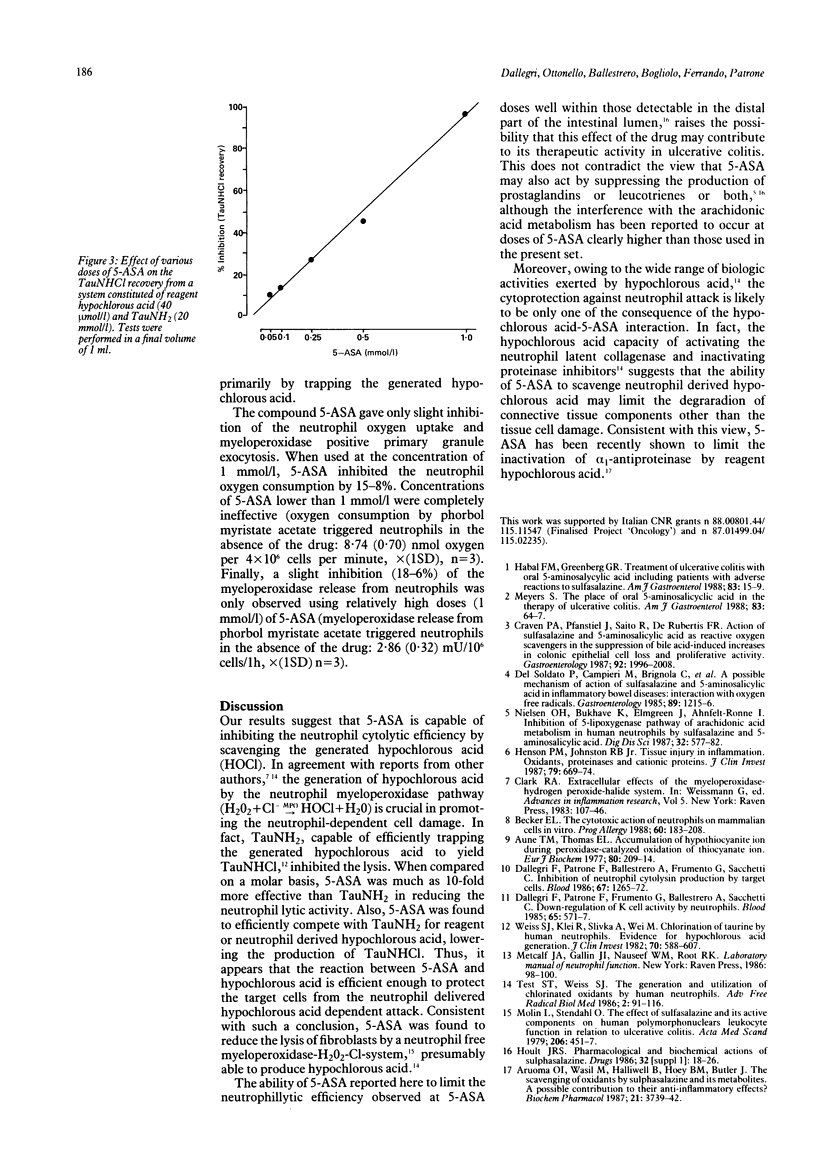Abstract
The aim of the present study was to investigate the effects of 5-aminosalicyclic acid (5-ASA) on the cell injury mediated by activated neutrophils. We used a system constituted of neutrophils, triggered with phorbol myristate acetate, and 51Cr-labelled Daudi cells as targets. The results show that 5-ASA is capable of efficiently preventing neutrophil-mediated lysis. 5-ASA was up to 10-fold more effective than taurine, which acts as an hypochlorous acid scavenger. Moreover, 5-ASA was found to compete with taurine for the neutrophil derived hypochlorous acid. The results are consistent with the conclusion that 5-ASA is capable of limiting the neutrophil mediated cell damage by scavenging the generated hypochlorous acid. This may represent a potential mechanism for the therapeutic action of 5-ASA in ulcerative colitis.
Full text
PDF


Selected References
These references are in PubMed. This may not be the complete list of references from this article.
- Aruoma O. I., Wasil M., Halliwell B., Hoey B. M., Butler J. The scavenging of oxidants by sulphasalazine and its metabolites. A possible contribution to their anti-inflammatory effects? Biochem Pharmacol. 1987 Nov 1;36(21):3739–3742. doi: 10.1016/0006-2952(87)90028-1. [DOI] [PubMed] [Google Scholar]
- Aune T. M., Thomas E. L. Accumulation of hypothiocyanite ion during peroxidase-catalyzed oxidation of thiocyanate ion. Eur J Biochem. 1977 Oct 17;80(1):209–214. doi: 10.1111/j.1432-1033.1977.tb11873.x. [DOI] [PubMed] [Google Scholar]
- Becker E. L. The cytotoxic action of neutrophils on mammalian cells in vitro. Prog Allergy. 1988;40:183–208. [PubMed] [Google Scholar]
- Craven P. A., Pfanstiel J., Saito R., DeRubertis F. R. Actions of sulfasalazine and 5-aminosalicylic acid as reactive oxygen scavengers in the suppression of bile acid-induced increases in colonic epithelial cell loss and proliferative activity. Gastroenterology. 1987 Jun;92(6):1998–2008. doi: 10.1016/0016-5085(87)90635-4. [DOI] [PubMed] [Google Scholar]
- Dallegri F., Patrone F., Ballestrero A., Frumento G., Sacchetti C. Inhibition of neutrophil cytolysin production by target cells. Blood. 1986 May;67(5):1265–1272. [PubMed] [Google Scholar]
- Dallegri F., Patrone F., Frumento G., Ballestrero A., Sacchetti C. Down-regulation of K cell activity by neutrophils. Blood. 1985 Mar;65(3):571–577. [PubMed] [Google Scholar]
- Del Soldato P., Campieri M., Brignola C., Bazzocchi G., Gionchetti P., Lanfranchi G. A., Tamba M. A possible mechanism of action of sulfasalazine and 5-aminosalicylic acid in inflammatory bowel diseases: interaction with oxygen free radicals. Gastroenterology. 1985 Nov;89(5):1215–1216. doi: 10.1016/0016-5085(85)90251-3. [DOI] [PubMed] [Google Scholar]
- Henson P. M., Johnston R. B., Jr Tissue injury in inflammation. Oxidants, proteinases, and cationic proteins. J Clin Invest. 1987 Mar;79(3):669–674. doi: 10.1172/JCI112869. [DOI] [PMC free article] [PubMed] [Google Scholar]
- Hoult J. R. Pharmacological and biochemical actions of sulphasalazine. Drugs. 1986;32 (Suppl 1):18–26. doi: 10.2165/00003495-198600321-00005. [DOI] [PubMed] [Google Scholar]
- Lantz B., Carlmark B., Reizenstein P. Electrolytes and whole body potassium in acute leukemia. Acta Med Scand. 1979;206(1-2):45–50. doi: 10.1111/j.0954-6820.1979.tb13467.x. [DOI] [PubMed] [Google Scholar]
- Meyers S. The place of oral 5-aminosalicylic acid in the therapy of ulcerative colitis. Am J Gastroenterol. 1988 Jan;83(1):64–67. [PubMed] [Google Scholar]
- Nielsen O. H., Bukhave K., Elmgreen J., Ahnfelt-Rønne I. Inhibition of 5-lipoxygenase pathway of arachidonic acid metabolism in human neutrophils by sulfasalazine and 5-aminosalicylic acid. Dig Dis Sci. 1987 Jun;32(6):577–582. doi: 10.1007/BF01296156. [DOI] [PubMed] [Google Scholar]
- Weiss S. J., Klein R., Slivka A., Wei M. Chlorination of taurine by human neutrophils. Evidence for hypochlorous acid generation. J Clin Invest. 1982 Sep;70(3):598–607. doi: 10.1172/JCI110652. [DOI] [PMC free article] [PubMed] [Google Scholar]


